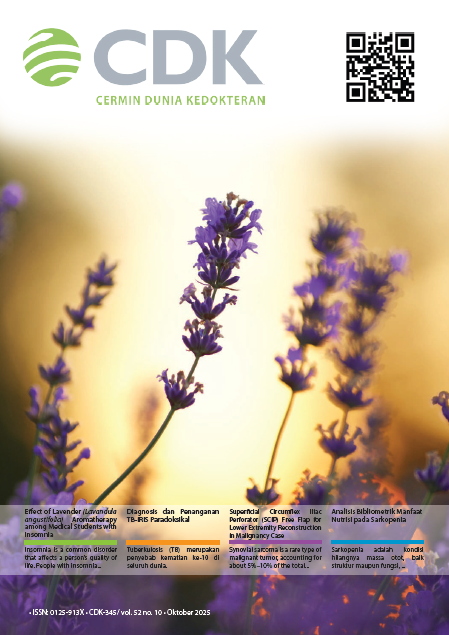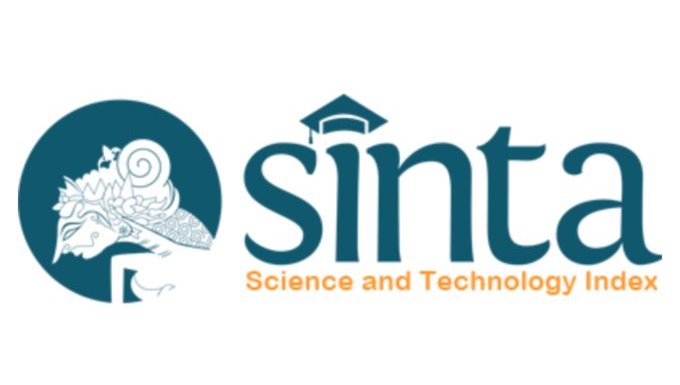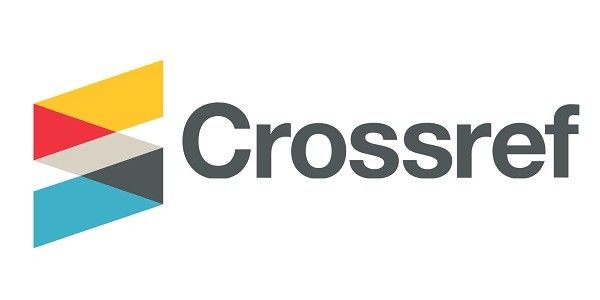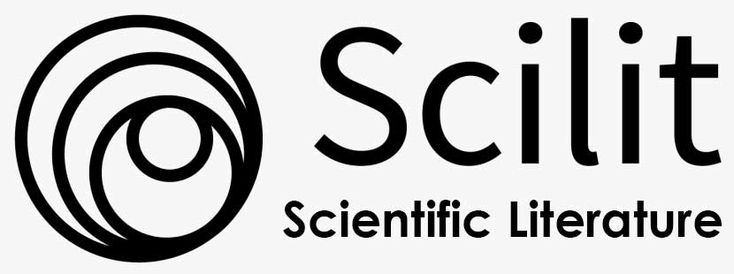The Use of Collagen Stimulators in Aesthetics
Analysis
DOI:
https://doi.org/10.55175/cdk.v52i10.1088Keywords:
Collagen stimulator, dermal filler aesthetic, estetika, facial aging, penuaanAbstract
Aging is a life cycle stages accompanied by physiological and anatomical changes as biological aging process. Various methods of prevention and management are used to reduce the appearance of facial aging, among others is minimally invasive procedure. Dermal fillers or soft tissue fillers are one of the minimally invasive procedures aimed at restoring facial volume and augmenting specifc areas. Dermal fillers are divided into two categories, non-biodegradable and biodegradable. Biodegradable fillers are known as collagen stimulators.The use of collagen stimulators such as polycaprolactone (PCL), calcium hydroxylapatite (CaHa), and poly-L-lactic acid (PLLA) is increasingly popular due to their ability to stimulate natural collagen production, resulting in long-lasting and natural-looking outcomes. Each type has unique characteristics, indications, and injection techniques, making product and method selection important for optimal patient results. Side efects such as edema, nodules, or infammatory reactions can be minimized with proper technique and administration by trained medical professionals. With advances in technology and improved understanding, collagen stimulators have become an efective solution for soft tissue rejuvenation and augmentation in aesthetic practice.
Downloads
References
Estebsari F, Dastoorpoor M, Khalifehkandi ZR, Nouri A, Mostafaei D, Hosseini M, et al. The concept of successful aging: a review article. Curr Aging Sci. 2020;13(1):4–10. doi: 10.2174/1874609812666191023130117.
Swift A, Liew S, Weinkle S, Garcia JK, Silberberg MB. The facial aging process from the “inside out.” Aesthet Surg J. 2020;41(10):1107–19. doi: 10.1093/asj/sjaa339.
American Society of Plastic Surgeons. Plastic surgery statistics [Internet]. 2024 [cited 2022 Aug 29]. Available from: https://www.plasticsurgery.org/news/plastic-surgery-statistics
Dastoor SF, Misch CE, Wang HL. Dermal fillers for facial soft tissue augmentation. J Oral Implantol. 2007;33(4):191–204. doi:
1563/1548-1336(2007)33[191:DFFFST]2.0.CO;2.
Carruthers J, Carruthers A, Humphrey S. Introduction to fillers. Plast Reconstr Surg. 2015;136(5 Suppl):120S-31S. doi: 10.1097/PRS.0000000000001770.
Christen MO, Vercesi F. Polycaprolactone: how a well-known and futuristic polymer has become an innovative collagen-stimulator in esthetics. Clin Cosmet Investig Dermatol. 2020;13:31–48. PMID: 32161484.
de Melo F, Nicolau P, Piovano L, Lin SL, Baptista-Fernandes T, King MI, et al. Recommendations for volume augmentation and rejuvenation of the face and hands with the new generation polycaprolactone-based collagen stimulator (Ellanse). Clin Cosmet Investig Dermatol. 2017;10:431–40. doi: 10.2147/CCID.S145195.
Guo J, Fang W, Wang F. Injectable fillers: current status, physicochemical properties, function mechanism, and perspectives. RSC Adv.
;13(34):23841–58. doi: 10.1039/d3ra04321e.
Lin S, Christen M. Polycaprolactone-based dermal filler complications: a retrospective study of 1111 treatments. J Cosmet Dermatol.
;19(8):1907–14. doi: 10.1111/jocd.13518.
Hanf E, Gresser U. Battle against aging and folds: benefit and risks of the semi-permanent fillers polylactic acid and calcium hydroxylapatite. Adv Aging Res. 2014;3(2):130–41. http://dx.doi.org/10.4236/aar.2014.32021.
de Almeida AT, Figueredo V, da Cunha ALG, Casabona G, Costa de Faria JR, Alves EV, et al. Consensus recommendations for the use of hyperdiluted calcium hydroxyapatite (Radiesse) as a face and body biostimulatory agent. Plast Reconstr Surg Glob Open. 2019;7(3):e2160. doi: 10.1097/GOX.0000000000002160.
Loghem JV, Yutskovskaya YA, Werschler WP. Calcium hydroxylapatite: over a decade of clinical experience. J Clin Aesthet Dermatol. 2015;8(1):38–49. PMID: 25610523.
Jacovella PF. Use of calcium hydroxylapatite (Radiesse) for facial augmentation. Clin Interv Aging. 2008;3(1):161–74. doi: 10.2147/cia.s2065.
Jansen DA, Graivier MH. Evaluation of a calcium hydroxylapatite-based implant (Radiesse) for facial soft-tissue augmentation. Plast Reconstr Surg. 2006;118(3 Suppl):22S-30S, discussion 31S-33S. doi: 10.1097/01.prs.0000234903.55310.6a.
Pavicic T. Complete biodegradable nature of calcium hydroxylapatite after injection for malar enhancement: an MRI study. Clin Cosmet Investig Dermatol. 2015;8:19–25. doi: 10.2147/CCID.S72878.
Amselem M. Radiesse: a novel rejuvenation treatment for the upper arms. Clin Cosmet Investig Dermatol. 2015;9:9–14. doi: 10.2147/CCID.S93137.
Sattler G, Walker T, Buxmeyer B, Biwer B. Efficacy of calcium hydroxylapatite filler versus hyaluronic acid filler in hand augmentation. Aktuelle Dermatol. 2014;40:445–51. https://doi.org/10.1055/s-0034-1378110.
Kadouch JA. Calcium hydroxylapatite: a review on safety and complications. J Cosmet Dermatol. 2017;16(2):152–61. doi: 10.1111/jocd.12326.
Haddad A, Kadunc BV, Guarnieri C, Noviello JS, Cunha MGD, Parada MB. Current concepts in the use of poly-L-lactic acid for facial rejuvenation: literature review and practical aspects. Surg Cosmet Dermatol. 2017;9(1). https://doi.org/10.5935/scd1984-8773.201791952.
Vleggaar D, Fitzgerald R, Lorenc ZP. Composition and mechanism of action of poly-L-lactic acid in soft tissue augmentation. J Drugs Dermatol JDD. 2014;13(4 Suppl):s29-31. PMID: 24719074.
Stein P, Vitavska O, Kind P, Hoppe W, Wieczorek H, Schurer NY. The biological basis for poly-L-lactic acid-induced augmentation. J Dermatol Sci. 2015;78(1):26–33. doi: 10.1016/j.jdermsci.2015.01.012.
Vleggaar D. Facial volumetric correction with injectable poly-L-lactic acid. Dermatol Surg. 2005;31(11 Pt 2):1511–7; discussion 1517-1518. doi: 10.2310/6350.2005.31236.
Munia C, Parada M, de Alvarenga Morais MH. Changes in facial morphology using poly-l-lactic acid application according to vector technique: a case series. J Clin Aesthetic Dermatol. 2022;15(7):38–42. PMID: 35942018.
Vleggaar D. Soft-tissue augmentation and the role of poly-L-lactic acid. Plast Reconstr Surg. 2006;118(3 Suppl):46S-54S. doi: 10.1097/01.prs.0000234846.00139.74.
Cabral L, Teixeira L, Gimenez R, Demasi A, Junior R, Araújo V, et al. Effect of hyaluronic acid and poly-l-lactic acid dermal fillers on collagen synthesis: an in vitro and in vivo study. Clin Cosmet Investig Dermatol. 2020;13:701–10. doi: 10.2147/CCID.S266015. eCollection 2020.
Downloads
Published
How to Cite
Issue
Section
License
Copyright (c) 2025 Della Sulamita Mahendro

This work is licensed under a Creative Commons Attribution-NonCommercial 4.0 International License.





















